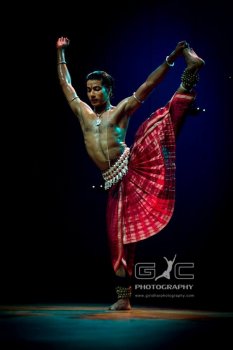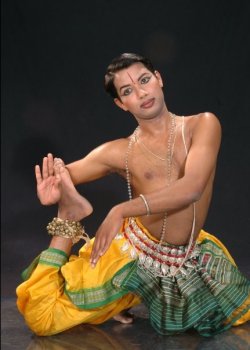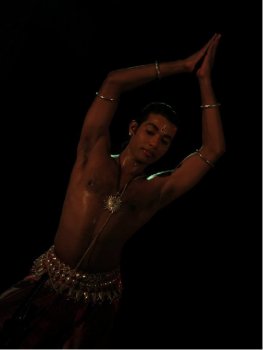
|
 |

|
 |
Rahul Acharya: a devotee of dance - Lalitha Venkat e-mail: lalvenkat@yahoo.com March 26, 2014  A student of Pt Durga Charan Ranbir, Odissi dancer Rahul Acharya is based in Bhubaneshwar, Orissa. A torch-bearer of the Guru Deba Prasad Das style, he was the first male Odissi dancer to be honored with the Ustad Bismillah Khan Yuva Puraskar award from the Government of India in 2009. Other than his dance, Rahul is an avid devotee of Lord Jagannatha and well versed in Sanskrit. He is trained in Hatha Yoga and Raja Yoga in the Bihar School of Yoga. He enjoys reading and researching on Shastras (scriptures) and bringing them to the forefront through his dance. Here, Rahul Acharya shares his views on a variety of matters pertaining to Odissi dance. With the rising popularity of Odissi, do you think the traditional movements are in any way being affected? Tradition is a transitioning element. There is no static tradition. Customs, beliefs and practices have been altered frequently to suit the changing times. What we practice as Odissi today is certainly not what Bharata mentioned as Odra Magadhi in the Natya Shastra. The style of Odissi that we practice today was not what it was during the 50's. When the repertoire of Odissi was being developed the entire Margam hardly lasted 15-20 mins. Today, one single choreography can go on for hours. Thus there is no one tradition that dancers need to stick to. But there is a basic underlying grammar that characterizes Odissi's antiquity and uniqueness. We have all learnt it as beginners and have practiced it ever since. This basic grammar is the building block of the dance form. Thus it becomes quite important to understand and digest what our masters have passed down to us. We need to preserve this rich legacy that has been handed over to us and take it a step further with our own innovations. It is heartening to see the rising popularity of Odissi world over, but there are pros and cons as well. Dancers of the present genre are doing really well. They are approachable, cordial, hard-working and above all, grounded. They are like a breath of fresh air. But amidst all these pros, the cons are equally visible, where some half-baked dancers do not put in the amount of work needed and claim to be the know-all kind. With them, anything goes in the name of contemporary and fusion. Fusion becomes confusion and contemporary is all but temporary. We must not forget our roots no matter how modern we become. We should always remember the rich legacy that we have inherited from our gurus and need to act as custodians of all that has been passed down to us and take it ahead with our own creativity. The motto, "First learn the rules and then break them"... In order to break the rules, we need to learn them first.  Nowadays, some Bharatanatyam dancers have started wearing the typical Odissi belt as part of their costume. The Odissi belt typically referred to as Bengapatia or Bhekamukha referring to the mouth of a frog it resembles, was a very unique piece of girdle worn by the Maharis that was later adapted by Odissi dancers. Silver ornaments, the head gear or Tahia and indigenous sarees of Orissa are Odissi's trademark. They provide some kind of an identity to Odissi. Similarly each dance form has its own aharya. It has been noticed of late that some Bharatanatyam dancers are using the Odissi belt. In my opinion it is better to remain authentic to the aharya designed for each dance form in order to avoid confusion. Many dancers are getting trained in kalaripayattu. Do you think it is essential for an Odissi dancer to be trained in kalaripayattu, for fitness or for any other purpose... We all know that martial forms are superb physical training programs that enhance the durability of a practitioner's body thereby increasing their endurance level. It could be anything from Yoga to Pilates to Kalari to Zumba to anything. We all believe that Shiva is the Lord of dance; Shiva is also considered the Lord of Hatha Yoga. Thus Shiva was not only well versed in dance but with Yoga too. I personally suggest dancers to learn Yoga that proves to be very beneficial. I say this from my personal experience. I have been a Yoga practitioner since childhood. Any form of physical training is excellent for conditioning the body of a dancer in general. Learning regional martial forms does provide added benefits to the dancer practicing that regional form of dance. Dance varies from region to region, that is why we have 8 different classical dance styles and many regional variations. This is because dance is certainly influenced by the ambience of the region it belongs to, its people, their customs, beliefs and practices. I don't think it is essential for an Odissi dancer to learn Kalari when we have our own martial forms like the akhada culture of Puri, Piko, Chhau etc. but there is no harm if someone wants to learn it. To each his own. Compared to number of male dancers in other classical dance forms, there seem to be a lot of male dancers in Odissi. And they seem to be doing well in group or solo. It is really overwhelming to see a growing number of male Odissi dancers compared to other dance styles. Right from the times of the Natya Shastra, it has been men who have carried down the legacy of dance. It started with Bharata, Tandu, Gargacharya, Rantideva, Attahasa and so on and so forth. The gurus have all been men. Here I am not being sexist but time stands testimonial that the custodians of our rich forms have all been men, but due to lack of patronage, they either stuck to being gurus or left to try their hands at other professions as art was never lucrative. Very rarely did we find male dancers as performers on stage. But the ice has been broken with increasing number of male Odissi dancers taking to stage performances in a major way. Why only in Odissi, there are outstanding male dancers in other dance styles also who are doing brilliant work. Just that the number is more in Odissi.  When you conduct workshops abroad, what do you notice most among Odissi practitioners there? I usually design my workshops to suit a heterogeneous group of dancers, not belonging to one particular style only. I emphasize a lot on body conditioning techniques to prepare a dancer to cope with the rigours of Indian classical dancing. Most of these have been taken from my own Yoga background. I usually don't teach items in my workshops, unless I see the preparedness of a dancer that should match my expectation. Only then do I teach items. The feedback is extremely overwhelming. I am really bowled over by their eagerness to understand all that they have been learning with attention to minutest details. Most of my students have come to me through these workshops. How essential is it for a dancer, Odissi or any other form, to be well versed in Sanskrit? It is extremely essential for an Indian classical dancer to be well versed in Sanskrit and the vernacular language used in the dance, in this case Oriya for Odissi. When we say shastriyanritya it refers to the dance style mentioned in our shastras or scriptures and all our scriptures are written in Sanskrit. In most cases it is observed that there is no proper English substitute to a lot of expressions used in Sanskrit. For example, the word Ananda. The closest English counterpart would be bliss or ecstasy, but many would agree that Ananda is much more than what our English counterpart has to offer. Language forms an essential component of dance. Abhinaya is defined as poetry in action and there is no poetry without language. In order to gain first-hand knowledge of any scripture, one needs to know Sanskrit. A lot of essence is lost in translations and there can never be a perfect translation. So we dancers need to put in extra effort to learn the Sahitya as well. Only learning and perfecting techniques does not suffice. Dancers need to cultivate two things: Auchitya and Sahitya. Many dancers profess to dance according to the Natya Sastra. Your comments. Natya Shastra is a vast text. What we refer to as Natya Shastra today is the one consisting of 6,000 shlokas and is called the Shadshahasrisamhita. There is another Natya Shastra consisting of 12,000 shlokas and is called the Dwadashashahasri Samhita. The entire latter text is yet to be fully discovered. It is impossible for any dancer to use the entire practical techniques that the Natya Shastra talks about. However, extensive work has been done by Dr. Padma Subrahmanyam as we all know and there are number of dancers who are undertaking serious study of the Natya Shastra. This needs to be encouraged. There seems to be a proliferation of festivals, competitions and awards in Odisha. Orissa has become a hot bed of festivals. For 365 days in a year something or the other is happening. We are literally saturated with festivals. This certainly provides an opportunity for many dancers and thus encourages talent. But with the increasing number of festivals, the quality is slowly deteriorating. Similarly the awards too, are losing their value. It is like 'you award me and I award you' policy. Most of these awards do not have a standing and thus don't hold good. It is also confusing to check the authenticity of such awards. How do you balance your frequent travel overseas with your own dance training? I usually follow a very strict body training regimen that I don't compromise with no matter in whichever part of the world I am in. This gives me a tremendous amount of confidence and stamina to keep up with frequent travels and performances. I train my students whenever I get the time. I usually devote 3-4 months of dedicated training to my students towards the end of each year and the beginning of the new year. Because of my own schedule I don't take in too many students as I find it really difficult to manage my own work and since I am a performing artist, certainly my dance is a priority. Thus, I have very few students who are full time dancers and are very dedicated. I keep a track of their progress almost every week. With the advancement in technology and thanks to the web the world has become a smaller place and this helps me to keep track of my students. How would you describe the experience of performing overseas as against performing in your home state? For a dancer, while dancing, the stage does not matter. The whole experience of dance is such that one loses oneself completely and is driven to a state of ananda. During this transformation, the dancer loses his/her identity and the stage becomes a temple courtyard. The geographical location hardly matters. Dance actually erases boundaries. As dancers we all speak the same language. Yes, dialects vary. But then we tend to understand one another. It is the aftermath of the performance that brings you back from this tranquility when you realize where you are dancing. For me, the responses that I have received both at my home state and elsewhere has always been very overwhelming and extremely encouraging. The positivity that people bring with them in fact inspires me to get better with each passing day. I have always been a devotee of dance and have nurtured this aspiration to reach a state where my physical body is completely consumed by dance. What do you think can be done for the growth and development of Odissi? Odissi has, as a matter of fact, outgrown itself. It has spread itself all over the world and has lent the state of Orissa its identity. Odissi has put Orissa on a global cultural map. People recognize this state as the land of Jagannath and Odissi. And all this is very encouraging, but this has also led to a tremendous amount of mediocrity that is hard to deal with. Not all dancers get an opportunity or exposure and thus sustaining oneself as a performing artist only becomes extremely difficult. As a result most of them land up learning little and teaching more. This trend is extremely dangerous and needs to be attended to seriously. We need to educate dancers and make them understand that dance is not all technique but a lot of theory as well. Indian dance has a history as antique as human civilization and as dancers we need to be not only aware but also thorough with it, to be able to become the faces of not only Odissi but any form. This needs to be addressed globally. Contact Rahul Acharya: rahul_acharya@rediffmail.com Comments * On Nov 29, 2015 I had an opportunity to watch Odissi dance of Rahul Acharya. It was an enchanting performance classical dance with Sonali Mohapatra and Gayatri Ranbir. My sincere congratulations. - C. Satheesan Nair, Dec 1, 2015 Post your comments Unless you wish to remain anonymous, please provide your name and email id when you use the Anonymous profile in the blog to post a comment. All appropriate comments posted with name & email id in the blog will also be featured in the site. |